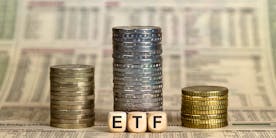Best Gold ETFs for Income and Growth: 2025 Edition
All products and services featured are independently selected by WikiJob. When you register or purchase through links on this page, we may earn a commission.
Leverage can boost profits but also magnify losses, potentially exceeding your initial investment. Always weigh the risks carefully.
For investors looking to build a diverse and low-cost portfolio, exchange-traded funds (ETFs) can be a great option.
Unlike active investments, where a fund manager will buy and sell stocks quite quickly based on their current performance, ETFs are passive investments.
They require a ‘buy and hold’ mentality, and you must resist the temptation to react to the fluctuating stock market.
If you’re in it for the long run, ETFs can be a very cost-effective way to invest.
There are several types of ETFs, including index, bond, currency and commodity.
Gold is a commodity ETF, among other materials such as oil, copper and lithium. Gold ETFs track the price of real gold, so you can invest in the precious metal without needing to source physical gold bars or bullion.
If you are looking to begin investing in gold ETFs, it is important to understand the brokers that will provide you with the best experience. All of the gold ETF brokers in this guide are fantastic platforms through which to start your investment journey.
In this guide, you will learn everything you need to know about gold ETFs and the best brokers to work with. You will also get answers to frequently asked questions.
Best Gold ETF Brokers for 2025
1. Plus500
Pros
- Regulated by the Financial Conduct Authority
- Over 2,500 significant financial instruments
- Negative balance protection
- 24/7 customer support
Cons
- No API integrations
- No social copy trading
Plus500 currently offers three platforms:
- Plus500CFD, featuring over 2,800 CFD instruments
- Plus500Invest, providing access to more than 2,700 shares (available in select countries)
- Plus500Futures, which is exclusively available in the US
Known for its user-friendly platform and zero commission trading, Plus500 offers a straightforward experience for gold ETF trading. It’s ideal for beginners and advanced traders alike, featuring real-time quotes, advanced charting tools and a demo account for practice. Plus500 is also regulated in multiple jurisdictions, ensuring a high level of security.
Buying Gold ETFs on Plus500 allows traders to speculate on the price of gold without physically owning the asset. On the platform, you can trade Gold ETFs CFDs, which are contracts that track the performance of gold ETFs. This enables you to take positions on whether the price of gold or a gold-related ETF will rise or fall.
When you buy a Gold ETF CFD on Plus500, you don’t actually own the underlying ETF but rather enter a contract to exchange the difference in the price of the asset from the point of purchase to the point of sale. The advantage of trading CFDs on Gold ETFs is that you can use leverage, meaning you can control a larger position with a smaller investment. However, leverage increases both the potential for profit and the risk of loss, making it important to carefully manage your risk.
To trade Gold ETFs on Plus500, you’ll need to select the specific ETF you want to trade, choose your position size, and decide whether you want to go long (buy) or short (sell). Keep in mind that Plus500 offers real-time price tracking, and you can close your position at any time based on market conditions. As with any leveraged product, it’s essential to understand the risks involved, especially given the volatility that can occur in the gold market.
2. eToro
Pros
- Regulated by FCA, ASIC
- No withdrawal fee for US clients
- 0% commission on stocks
- Social and copy trading
Cons
- Not available in every US State
- More expensive than most of its competitors
- No MetaTrader platforms
Buying Gold ETFs on eToro allows traders to invest in gold without directly owning the asset. On eToro, you can trade Gold ETF CFDs, which are contracts that mimic the performance of gold ETFs. These CFDs allow you to speculate on whether the price of a gold-related ETF will rise or fall, providing an opportunity to profit from price movements in the gold market.
When you buy a Gold ETF CFD on eToro, you’re not purchasing the physical ETF itself but entering into a contract to exchange the difference in price from when you open to when you close your position. This enables you to trade gold ETFs without needing to own the underlying shares. One of the benefits of trading CFDs on eToro is the ability to use leverage, meaning you can potentially gain a larger exposure to the market with a smaller initial investment. However, leverage also increases both the potential for profits and the risks, so it’s essential to manage your risk carefully.
To trade Gold ETFs on eToro, you simply select the ETF you wish to trade, choose your position size, and decide whether you want to buy or sell. eToro also offers tools like stop-loss orders and take-profit orders, which can help manage risk by automatically closing your position at a set price. As with any leveraged product, it’s important to fully understand the risks involved in trading CFDs, particularly given the potential volatility in the gold market.
61% of retail investor accounts lose money when trading CFDs with eToro. You should consider whether you understand how CFDs work, and whether you can afford to take the high risk of losing your money.
3. Interactive Brokers
Pros
- Regulated
- Wide range of offerings
- Low commission
- Socially responsible
- 24/5 customer support across multiple channels
Cons
- No additional platforms
- Inactivity fees
Buying Gold ETFs on Interactive Brokers allows you to directly invest in gold or gold-related assets through a range of gold ETFs. Unlike CFDs, when you purchase a Gold ETF on Interactive Brokers, you are buying shares in the fund itself, which tracks the performance of gold or gold mining companies. This means you own a portion of the ETF and have the potential for long-term growth and income, depending on the type of ETF (e.g., physical gold-backed or mining-related ETFs).
To buy Gold ETFs on Interactive Brokers, you simply search for the ETF you’re interested in, such as SPDR Gold Shares (GLD) or iShares Gold Trust (IAU), and place an order to buy shares. You can purchase ETFs in the same way you would with stocks, using cash or margin accounts. Interactive Brokers also offers a range of tools and research to help you make informed decisions, including real-time market data, detailed charting, and risk management features.
One of the key advantages of buying Gold ETFs on Interactive Brokers is the ability to directly own the ETF shares, rather than trading on leverage through CFDs. This makes it a more straightforward investment option for those looking to gain exposure to gold with less risk than leveraged trading. Interactive Brokers also provides access to a broad selection of gold ETFs, allowing you to diversify your gold investment strategy, whether you’re looking for direct exposure to gold prices or the potential for growth through gold mining companies.
What Are Gold ETFs?
There are two types of gold ETF: Physical Gold ETFs and Gold Mining ETFs.
A Physical Gold ETF is an investment fund that tracks the price of gold.
In purchasing a digital representation of gold, you are investing directly in physical gold bullion. Your ETF will mirror the price of real gold or gold-related indices.
Every unit of a gold ETF represents one gram of gold that is of 99.5% purity. The real gold is stored in vaults and the ETFs act as a simple and accessible way for investors to buy and sell this precious commodity.
The second type of Gold ETFs are Gold Mining ETFs. Purchasing these means you are investing in the companies involved in extracting gold from the earth. Rather than owning a specific amount of gold, you will have a share in the firm’s portfolio of gold.
Just like the value of physical gold can go up and down, your stake in the gold mining firm will fluctuate with stock market trends.
Put simply, Gold ETFs hold physical gold, and Gold Mining ETFs hold portfolios of mining companies’ gold stocks.
For investors, there are many benefits to investing in gold ETFs. They can be very beneficial for income and growth.
One of the key advantages of investing in ETFs is that it provides you instant access to precious metals. An ETF buys you gold in an electronic format. This means that you do not need to source a physical format of gold. More importantly, you do not have to foot the cost of storage and insurance that comes with it.
Whether you have been buying and trading for years, or are now ready to begin your investing journey, gold ETFs are a great option that will diversify your portfolio.
Gold ETFs are also considered to be good hedges against inflation. As the purchasing power of the dollar declines, the value of this precious metal continues to rise.
Why Invest in Gold ETFs for Income and Growth?
Leverage can boost profits but also magnify losses, potentially exceeding your initial investment. Always weigh the risks carefully.
Investing in Gold ETFs is a great way to build a portfolio that delivers income and growth, especially if you take advantage of their unique features. As well as having low fees due to being passive investments, gold ETFs can reward you with exponential growth.
Some Gold Mining ETFs pay dividends, meaning that payments are made back to you based on how many shares you hold. If you intend to keep your investment long term, receiving dividends can provide a steady source of income.
By investing in companies involved in gold mining, you can benefit from some risk protection should the market go through a volatile phase. It provides an assurance that even if the gold market is performing poorly, you may receive a distribution of profit through quarterly or annual dividends. It is important to note that this does not apply to Physical Gold ETFs. Only Gold Mining ETFs can pay dividends.
In the current economy, shielding your investments and opting for safer bets are a wise move to make.
A pattern has emerged in recent times where gold has demonstrated low correlation with traditional financial assets such as stocks and bonds. When equity shares are low, gold is high, and vice versa. This makes gold a very valuable diversification tool. If you have stakes in Gold ETFs as well as equity funds, the balance can save your whole portfolio from underperforming.
As with any area of trading, there is no guarantee that your investment will perform well. It is important to be aware of the potential drawbacks that can come with investing.
While gold is typically a good performer on the stock market, the prices can be volatile. This can lead to knee-jerk trades that ultimately cause losses for long-term investors. While gold ETFs are typically good sources of income, they may not always bring you a profit.
Another thing to be aware of when considering investing in gold ETFs is taxation. If you plan to hold your ETFs long-term, you will be taxed on them after one year. The rate can be up to 20%, depending on your income bracket. However, this is lower than the rate for physical gold, which can be taxed up to 28% after 12 months.
With so many options for ETF brokers, it can be difficult to know where to start. If you feel overwhelmed by choice, you may feel like abandoning your investment goals altogether. It is crucial that you use the information in this guide to understand how each ETF platform can help you. Equipped with this knowledge, you can make an informed decision and start investing in gold ETFs.
Key Factors to Consider When Choosing a Gold ETF
When it comes to choosing a Gold ETF, you need to consider your goals and how each platform aligns with them.
Below are some of the criteria you should think about when selecting the best gold ETF for you.
Expense Ratio
To get the most out of your investment, you might want to consider choosing an ETF with a lower expense ratio.
A high expense ratio – the percentage of an ETF’s assets used to cover operating costs – can eat into the returns you receive on your investment. If you are paying a high percentage, it will be harder to reach your financial goals.
Liquidity
As an investor, you may want to hold onto your stocks, or you might wish to buy and sell more fluidly. If you want to do the latter, you will need to consider liquidity.
Liquidity refers to how easily an investor can buy or sell an asset without affecting its price. If you are trying to sell a non-essential asset, you may struggle to make your asking price. On the other hand, selling a popular item is likely to attract a string of buyers.
The good news is that gold ETFs are far more liquid than physical gold because they are easier to sell on the stock market.
Underlying Assets
There are several differences between Physical Gold ETFs and Gold Mining ETFs. It is important that you understand them and how each investment can affect income and growth.
If you invest in a Physical Gold ETF, you are purchasing a fixed amount of gold. Your ETF reflects the performance of real gold bullion without the hassle of buying and storing actual gold.
Gold ETFs typically perform well, and you can expect reliable growth. They are also easy to sell should you wish to.
Gold Mining ETFs differ in that your investment is in mining companies rather than a specific amount of gold. Unlike Physical Gold ETFs, Gold Mining ETFs can pay dividends. This means that you can receive a payment back from your investment, which will boost your income.
Performance History
When choosing an ETF, it is important that you do your research. Look into each of their track records and see how they typically perform. It is especially key that you consider how an ETF has fared during various market conditions.
How to Invest in Gold ETFs
Investing in an ETF is straightforward, but it’s important to understand the steps involved to ensure you make informed decisions.
Here’s a breakdown of how to get started:
Step 1. Choose a Brokerage Platform
The first step in investing in an ETF is to find a brokerage platform that offers ETF trading.
Platforms like Plus500, eToro, Interactive Brokers provide access to a wide range of ETFs, allowing you to choose the one that fits your investment goals.
Step 2. Consider Retirement ETFs for Long-Term Savings
In addition to traditional ETFs, many investors look into Retirement ETFs.
These ETFs are designed to help you save for retirement and can provide a safety net for your future.
They are a great way to ensure that your investments grow over time, offering a balanced portfolio that may include stocks, bonds, and other assets aimed at protecting your long-term financial security.
Step 3. Research and Select the Right ETF
After signing up with your chosen platform, take time to research the available ETFs.
Most brokerages provide detailed information on each ETF’s performance, holdings, and risk level.
Choosing the ETF that best suits your investment strategy is crucial, whether you’re focused on growth, income, or diversification.
Step 4. Consider Your Investment Strategy
Before you start investing, it’s helpful to have a strategy in place. One popular approach is Dollar-Cost Averaging (DCA).
With DCA, you invest a fixed amount of money at regular intervals—whether weekly, monthly, or quarterly—regardless of market conditions.
This strategy helps protect your portfolio from market volatility by diversifying your investments over time and preventing you from making large lump-sum investments that could be adversely affected by short-term market fluctuations.
The risks of investing in gold ETFs include a fluctuating market. Your investment can go down (as well as up) in price and so a profit is not always guaranteed.
If you wish to generate an income, you may wish to opt for Gold Mining ETFs. These stakes in mining companies can pay dividends that boost your income. Physical Gold ETFs can only make a profit if you sell your shares for a higher price.
As ETFs are passive investments, gold ETFs are great long-term. Gold can be volatile in the short term, so it is recommended you hold your stocks for a longer period of time.
You can hold gold ETFs in a retirement account such as a traditional or Roth IRA.
You can hold gold ETFs in a retirement account such as a traditional or Roth IRA.
Gold ETFs take away the hassle of buying and storing physical gold.
Final Thoughts on Choosing Gold ETFs for Income and Growth in 2025
When choosing a Gold ETF, it is important that you think about what you want from your investment. Aligning your ETF choice with your financial goals, whether income or growth, is key for making your investment work for you.
In addition to your own research, you may wish to consult a financial advisor for professional guidance. They can help you understand how to review and adjust your investments based on market trends.




